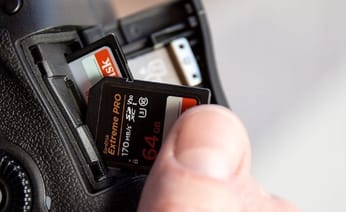Glossary
Table of Contents
Want help setting up your own backup workflow? I offer one-on-one consulting for photographers who’d rather not spend a weekend Googling file structures and cloud services. It’s practical, friendly, and totally tailored to your gear and goals.
8-bit vs 16-bit
This refers to how much color and tonal detail a file can store.
- 8-bit files can store about 16 million colors.
- 16-bit files can store over 280 trillion colors.
That extra bit depth gives smoother gradients, better shadow detail, and avoids “banding” in skies and other subtle areas. If you’ve done careful editing or shoot in RAW, export in 16-bit TIFF to preserve your work.
Catalog (Lightroom/Capture One)
This is where your editing software stores its “notes” about what you’ve done to each photo—every adjustment, rating, crop, etc. It also tracks where your original files live on your drive.
If you move your image files around outside the software, the catalog can lose track of them. Always move files inside the app to avoid breaking things.
CFExpress Type A Card
A compact high-speed memory card format used in some Sony and Nikon cameras. Smaller than Type B, but still significantly faster and more reliable than SD.
Backup Implication: Type A cards require specific readers, and offload speed can be limited by reader or cable bottlenecks. Physically small, so easy to misplace - label clearly.
CFExpress Type B Card
The current pro standard for high-performance stills and video. Much faster and more robust than SD, built on PCIe and NVMe tech (similar to SSDs). Used in cameras like the Canon R5, Nikon Z9, and Leica SL3.
Backup Implication: Fast offload speeds make dual-backup workflows efficient, but sudden catastrophic failure is more common than slow degradation. Always carry backups.
Compression Artifacts
These are unwanted visual side effects—like smudging, weird blocks, or banding—that happen when an image is saved using lossy compression, like a JPEG. You’ll see them most often in areas with smooth gradients or fine detail.
HDD (Hard Disk Drive)
Also called “spinning rust,” this is the older style of storage that uses physical spinning disks to read and write data. While slower and more fragile than SSDs, HDDs are still widely used because they offer high storage capacity at a much lower cost per terabyte. They’re great for bulk storage and long-term backups, especially in NAS systems.
JPEG (JPG)
Stands for: Joint Photographic Experts Group (yes, really)
JPEG (often abbreviated to "JPG") is the most common image format used for sharing and publishing photos. It’s supported everywhere—phones, printers, websites, you name it.
JPEG uses lossy compression, meaning it discards some image data to make the file size smaller. But how much it discards depends on the output settings—things like resolution, quality level, and compression ratio. Lower quality settings can lead to visible compression artifacts like banding, blockiness, or softness. Higher quality settings preserve more detail but result in larger files.
JPEGs are perfect for delivery—social media, email, web galleries, quick client previews. But they’re not ideal for editing or archiving, because every re-save can compound the loss of detail and color data.
If you’re done editing and want to share a photo, JPEG is the workhorse. If you’re still working on it, or want to preserve everything, go with TIFF or another lossless format.
Lossless
A file format that doesn’t throw away any image data to make the file smaller.
- TIFF is a common lossless format.
- JPEG is not—it discards data to shrink the file size.
Lossless formats are much better for archiving and printing.
NAS (Network Attached Storage)
A NAS is basically a box that holds one or more hard drives and connects to your home network. Think of it like a private cloud, your own personal file server that you control. You can access it from your computer, your phone, or even remotely (if you set that up safely).
Photographers often use NAS units for storing large archives, backups, or even active projects if the network is fast enough. Most NAS boxes can run automated backup software, sync with cloud services, and alert you if a drive fails. They almost always use traditional hard drives (see HDD) because they offer more storage per dollar than SSDs.
Just remember: a NAS is not a backup on its own. If your NAS is the only place your photos live, and it fails, they’re gone. Backups still need to live in more than one place.
Non-destructive Editing
This means your editing software (like Lightroom or Capture One) doesn’t change your original image file. Instead, it stores your adjustments in a separate file or database.
So when you crop, color correct, or sharpen, you're not “baking in” those changes—you can go back and tweak them later. But that also means you need to back up your edits (not just the RAWs) if you want to keep your work.
RAID (Redundant Array of Independent Disks)
RAID is a way of combining multiple physical hard drives into one logical unit for speed, redundancy, or both. It’s built into most NAS units and some high-end desktop setups. There are different “levels” of RAID (like RAID 1, RAID 5, RAID 6), each with its own mix of pros and cons.
The key idea: if one drive fails, you don’t necessarily lose data - depending on the RAID level, it can rebuild the lost drive from the others.
RAID is not a backup. It protects against hardware failure, not human error. If you delete a file, it’s instantly gone from all drives in the array. Same with file corruption or ransomware.
RAW File
The digital equivalent of a film negative. It captures all the data your sensor sees, giving you the most flexibility to edit. But it doesn’t include edits by default—you need to back those up separately or export them.
SD Card (Secure Digital)
The most common type of memory card, found in many consumer and enthusiast-level cameras. SD cards come in different speed classes and capacities (SDHC, SDXC, UHS-I, UHS-II). They’re inexpensive and widely supported, but also more prone to failure over time, especially if inserted and removed frequently or used in harsh environments.
Backup Implication: Slower read/write speeds and higher risk of silent corruption means frequent offloads and backup redundancy are important when using SD cards.
Session (Capture One only)
An alternative to catalogs in Capture One. Sessions keep everything—RAWs, edits, previews, and settings—in one tidy folder. They’re more portable and more forgiving if you move them around outside the app. Great for single projects or location shoots.
SSD (Solid State Drive)
A fast, modern type of storage with no moving parts. SSDs use flash memory (similar to memory cards or smartphones) to store data, which makes them faster, more durable, and quieter than traditional drives. They’re ideal for working drives, where speed matters, like editing or copying files.
TIFF
A file format often used for high-quality exports. Unlike JPEGs, TIFFs can store your edited image at full resolution and bit depth, without compression artifacts. Use 16-bit TIFFs to preserve your work in full quality.
XQD Card
A predecessor to CFExpress Type B, with similar size and design but slower performance. Still found in some Nikon bodies (e.g. D5, D850, Z6/Z7). Not as widely supported anymore.
Backup Implication: Slower than CFExpress, but more robust than SD. Fewer card readers available, so plan ahead when traveling or using older gear.
(You can expect this glossary to grow as more posts go up. If there's a term you've run into that you'd like explained, drop me a note.)



